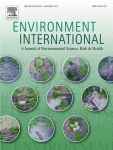Environment International 50
Overview of articles on POPs in a new issue of the Environment International journal.

Pages 15-21
Helen Engelstad Kvalem, Anne Lise Brantsæter, Helle Margrete Meltzer, Hein Stigum, Cathrine Thomsen, Margaretha Haugen, Jan Alexander, Helle K. Knutsen
- We model the blood concentrations of dioxins and PCBs on congener level.
- We use the models to predict the blood concentrations of dioxins and PCBs in an independent study population.
- We compared the predicted and the measured blood concentrations.
- The participants were to a great extent successfully placed in the right exposure category.
Pages 22-30
José L. Domingo, Gemma Perelló, Martí Nadal, Marta Schuhmacher
- Dietary exposure to PCDD/Fs in the vicinity of a HWI decreased considerable during the last 14years.
- Daily intakes of PCDD/Fs for different age/gender groups of the general population are notably lower than the TDI.
- Fish and seafood, oils and fats, and dairy products, are the food groups showing the highest contribution to total TEQ.
Pages 31-37
Yingxin Yu, Chunlei Li, Xiaolan Zhang, Xinyu Zhang, Yuping Pang, Shaohuan Zhang, Jiamo Fu
- Levels of DDTs and HCHs in food, dust and air samples from Shanghai, China
- Bioaccessibility of DDTs and HCHs in food was measured using an in vitro test.
- Daily uptake of DDTs and HCHs via ingestion, inhalation, and dermal contacts
- Ingestion via food and dust was the main route of human exposure to DDTs and HCHs.
- DDTs/HCHs from food consumption accounted for 95.0–99.2% of the total daily uptake.
2.11.2012




